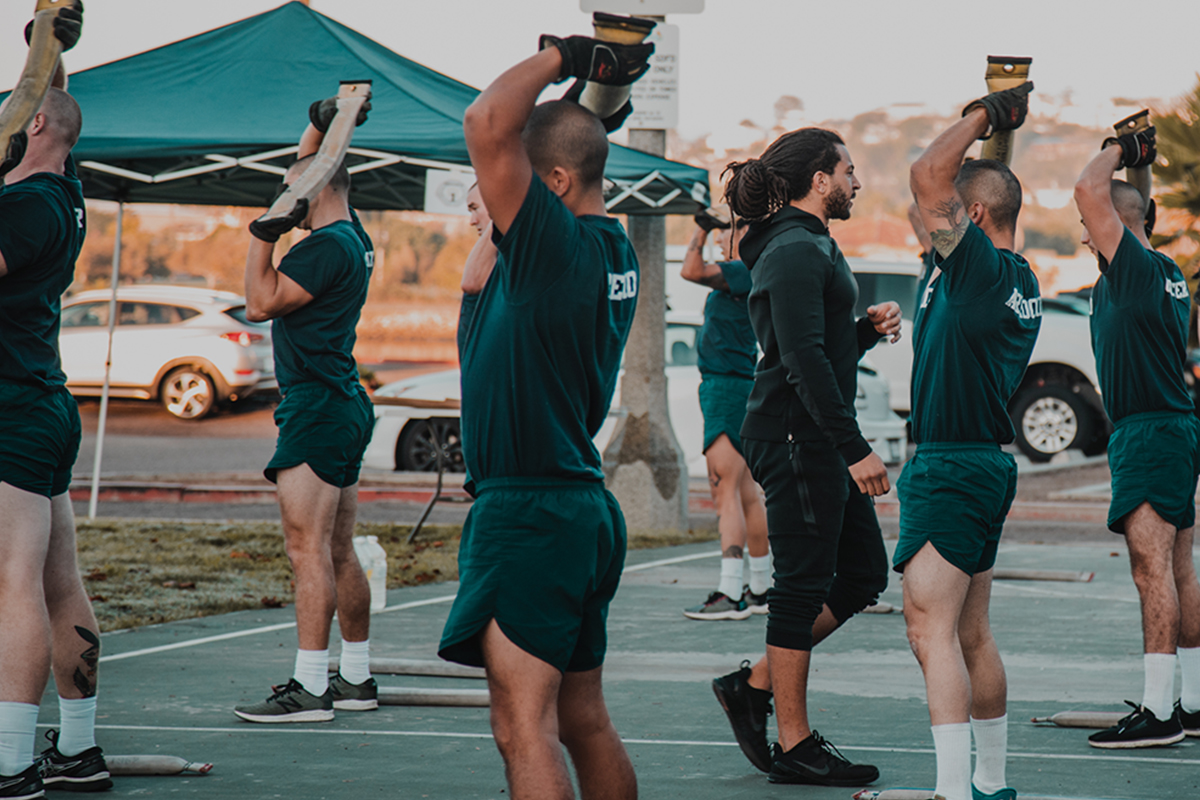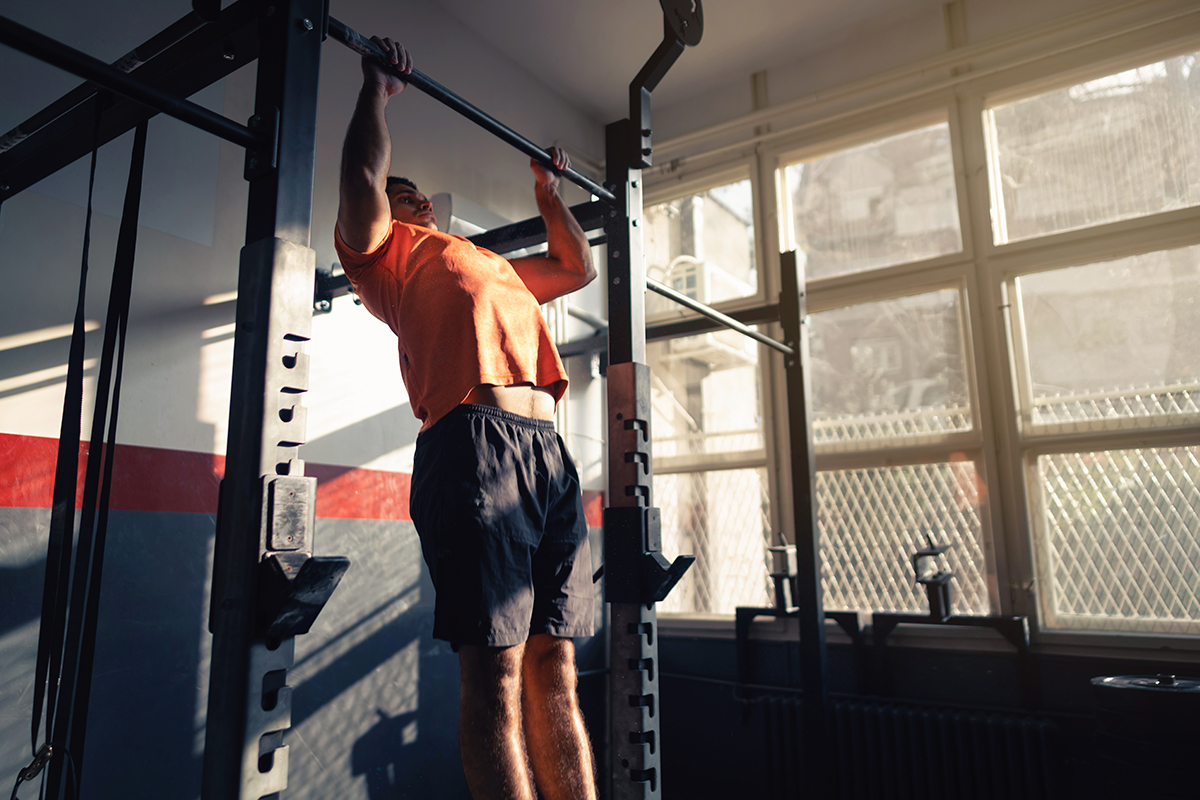My newest strength training obsession isn’t very new at all — it was etched in Egyptian hieroglyphics five-thousand years ago, perfected by Persian warriors in the 12th century and used as a melee weapon in the trenches of World War I. The mace, also known as a macebell, bludgeon, or gada, is one of civilization’s most ancient tools, and one that has long toed the line separating combat and fitness.
In certain circumstances, the mace has been a brutal weapon; Roman maces, for instance, were designed with spikes meant to break through the armor of enemies. In others, it’s simply been a piece of equipment meant to whip athletes into shape through creative means. “The Great Gama,” considered the greatest competitor in the history of India’s pehlwani wrestling tradition, is actually balancing a gada over one shoulder in his iconic portrait.
It’s fitting that the mace’s most recent comeback lands at the very intersection of combat and fitness. Since mixed martial arts took off in the early 2000s, UFC fighters have adopted the mace as part of a larger embrace of what’s known as “unconventional training tools.” Think: kettlebells, sandbags, truck tires, battle ropes, sledgehammers, and weighted bats. Some of these tools (like battle ropes) were invented recently. Others, like the mace, have been around forever.
The goal remains consistent throughout, though — build power and endurance at the same time. This is how modern special ops personnel train. It’s difficult to excel at life-or-death tasks off a routine that only prioritizes cardio or static weightlifting. You need agility, flexibility, mobility. You need to be prepared to lift or throw some truly random shit, where the weight is usually distributed unevenly. It requires an engaged core, a dynamic lower half and shoulders that can recruit their full range of motion.

According to Isaac Robertson, a fitness trainer at TotalShape, uneven weight distribution is a particular challenge with the mace, where the weighted bell is located almost four feet from a trainee’s grip. “It just forces your core to work overtime,” he says. “It challenges every smaller stabilizer muscle in your body.” Robertson’s also a fan of the mace’s versatility: “It’s perfect for high-repetition, whole-body movements, which makes it an extremely efficient tool.”
It’s easy to see why fighters — going into battle for Julius Caesar or into the octagon for Dana White — would benefit from this sort of training. It prepares them for (and protects against) the twists and thrusts of battle. You’re simply going to move better when you’ve trained your body to move as a whole. And a mace won’t just strengthen the delts and quads; it gets a number of oft-ignored regions involved, too, like the thoracic muscles, a group between the rib cage and spine.
Strengthening the thoracic muscles simultaneously opens up the upper back (by eliminating stiffness) and helps a fighter generate more power. But it also improves spine health, facilitates better breathing and limits potential for injury. Which is one reason why it isn’t just martial artists and GIs who stand to benefit from a mace — literally anyone performing movements that take a toll on the back should consider adding unconventional training to their repertoire.
Some of the most popular sports and pursuits for middle-aged men involve a violent back-and-forth in the upper half. You know: golf, tennis, swimming, kayaking. Playing the guitar isn’t so easy, either. That’s one reason Bob Weir, the legendary shaman-guitarist now touring the country with Dead & Company, warms up for his three-hours shows with a TRX kit and a steel mace. Yep. See it for yourself here. That man turns 74 in a week.

One other reason to try out a mace? It’s flat-out fun. Jack Craig, a personal trainer with Inside Bodybuilding, is a big fan. “I love implementing maces in workouts,” he says. “It’s such a different form of exercise for most athletes. It gives them a unique challenge.” As someone who’s been working out with a 10-pound steel mace from Onnit for a few weeks now, I can absolutely confirm those words.
Working out with a mace is a blast — and not just because you feel like a character from Game of Thrones when you walk around wielding one. It just makes for such an utterly refreshing brand of “lifting,” if you can even call it that. I like to work out with it in my backyard (knowing full well the looks I’d get if I carried it to the park, while my gym doesn’t have the space) and a simple six-move, 20-minute workout has my whole body absolutely fried. Here’s the circuit:
- Overhead squats, 5 reps per side
- Overhead press, 10 reps per side
- Spear press, 10 reps per side
- Mace 360s, 5 revolutions in each direction
- Joust with lunge, 5 reps per side
- High hinge rows, 10 reps per side
Perform the circuit three times through, with a few minutes of reach in between each. Some of these moves, like the overhead squats (hold the mace over your head, do squats), or the overhead press (lift it over your head as you would a traditional barbell) are self-explanatory; the unfamiliar modification is that the concentration of weight will be entirely on one side. But that’s only going to challenge your stabilizer muscles to work harder. Plus, making sure you perform reps with the macebell on both your right and left sides will make sure you don’t develop any imbalances yourself.
Where mace training gets its trickiest — and ultimately, its most fun — is with the 360 “halos.” It involves holding the mace directly in front of your chest, like you’re gripping a baseball bat, and inverting it fully around your head, to land back in the very same initial position. The key here is to keep the macebell facing up (it will desperately want to divebomb towards the ground).
Here’s a helpful chart of what this move works, but rest assured that it’s the entire upper body. Everything from the small muscles in your hands up to your triceps is needed to keep the mace level and in control. Some key takeaways? Definitely “choke up” on the mace, as you would when trying to hit with a heavier bat. Once you’ve trained with the mace for weeks, you can move slower down the handle, and position yourself further away from the weight. Also: don’t be discouraged if revolving one way seems easier at first, don’t rush through it, and don’t forget to clench your core.
The halos are a prime example for why your first mace should be nice and light. They make them in much heavier models — shove your pride aside for now. Unconventional training demands proper form. Once you master a move like the halo, it invites countless other exercises, like single-arm 360s and 10-to-2s. Think of this workout as a “gateway circuit.” It is far from what you can achieve with a mace, and that is a very good thing.
In fact, Craig’s favorite mace exercises are “pendulums and metronomes.” One involves swinging the mace back and forth behind your back (holding the handle even with the back of your neck), while the other tilting the tool in front of your chest, for slow, concentrated movements from one shoulder to the other. Point being, a mace is endlessly customizable, and once you’ve gotten enough reps in, you’ll realize that experimentation comes easy. Personally, I’m a big fan of the spear press, and anything that includes jousting, which is exactly what it sounds like.
An added bonus? It isn’t that expensive. One, 10-pound steel pace will run you $40. That’s the price of a dumbbell these days. It almost makes more sense to purchase for your home, too, considering it’s unlikely your gym will have one lying in the corner, waiting to be used. Mine is from Onnit, which is one of the most trusted manufacturers of functional fitness equipment these days. Their mace has a 4.9 rating on 663. Here’s review #664: it’s a 5.
Next time you’re yawning through another set of prison curls, make like the Sumerians, your favorite professional fighter, and goddamn Bob Weir, and get yourself a mace. The best fitness routine is a consistent one, yes, but that doesn’t mean it needs to be conventional.
This article was featured in the InsideHook newsletter. Sign up now.





















